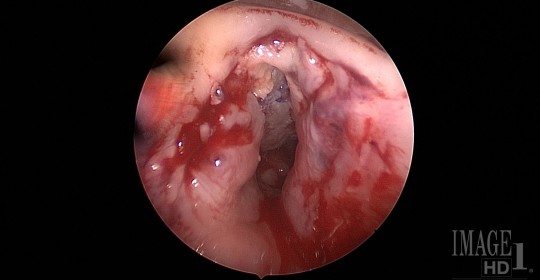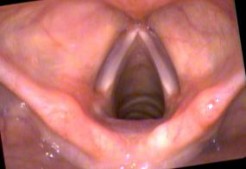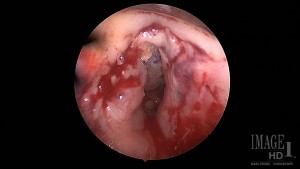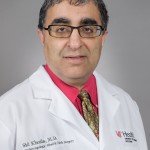
Case Study: Nationally Renowned Adult Airway Reconstruction Program
Laryngotracheal disorders can lead to stenosis of the airway, requiring highly complex reconstruction. The area involved is so small anatomically that endoscopy is difficult and open surgery is even more delicate, requiring a high level of expertise. With seven full-time surgeons performing the most challenging procedures, the University of Cincinnati Adult Airway Reconstruction Program is one of the busiest in the nation, treating close to 40 open cases per year surgically and another 200 endoscopically.
The Adult Airway Reconstruction Program is part of Neurosensory Disorders Program at University of Cincinnati Neuroscience Institute, and is led by director, Sid Khosla, M.D. Khosla details one particularly complicated case involving a female patient who had undergone radiation for cancer that caused vocal cord paralysis, as well as reduced vascularity of the remaining tissue, which impeded healing. Ultimately, the patient had almost no functional airway, with one vocal cord being completely destroyed, and the other 50% destroyed. There was also complete destruction of the anterior half of the cartilage and a large fistula between the skin and the endolarynx, resulting in a complete loss of speech and swallowing, and severely impaired breathing. Ordinarily, a laryngologist would have performed laryngectomy, due to the extreme level of damage to the patient’s larynx. However, says Khosla, “The patient absolutely did not want her larynx removed, and was willing to try an unproven procedure in order to increase the chance of breathing without a tracheotomy tube. If this was not a radiated larynx, we would transplant muscle and cartilage from the neck to the vocal cord area, subsequently using the tissue to recreate the vocal cords. However, due to severely compromised vascularity of all available neck cartilage and muscle, our team harvested tissue from another area instead using a free flap. Free flaps are often to reconstruct tissue defects in the head and neck such as those seen in tongue, pharyngeal and mandible, but free flaps have not been used to reconstruct this type of defect.
Khosla and his team harvested rib cartilage and placed it in the forearm; six weeks later, the combination radial forearm free flap and vascularized cartilage was harvested. The arm skin and soft tissue was used to provide mucosa for the lining of the new cord and the damaged external skin, and the soft tissue was used to provide bulk to the newly reconstructed folds. The patient has not yet regained her voice, but she can breathe on her own and does not require a tracheotomy.
Images: Patient’s pre-op photo (above) and normal vocal cords (below) to show contrast.

Clinicians at the Adult Airway Reconstruction Program routinely operate in the area of the laryngeal airway, where scarring between the vocal folds, in the subglottis, and in the trachea, requires a combination of procedures. They perform multiple open and minimally invasive procedures (such as laryngoscopy, bronchoscopy, and esophagoscopy), and can offer in-hospital post-surgical care especially for airway reconstruction patients. The program is an extension of Cincinnati Children’s Hospital Medical Center’s program, which is internationally renowned and performs five times more airway procedures than any other pediatric hospital in the world, and where Dr. Robin Cotton pioneered pediatric airway reconstruction.
Sid M. Khosla, MD
Director, UC Health Professional Voice Center
Director, UC Center for Laryngeal Biomechanics and Reconstruction
Associate Professor, Dept. of Otolaryngology/Head & Neck Surgery
(513) 558-1890
khoslasm@ucmail.uc.edu



